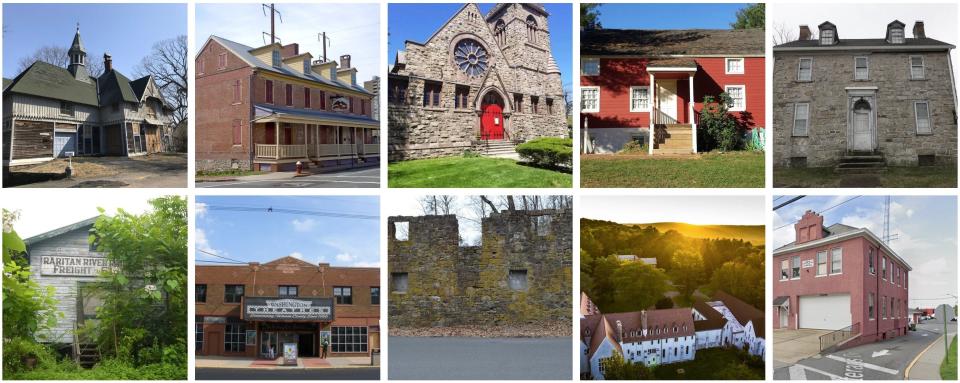These NJ landmarks made the list of 10 Most Endangered Historic Places
A pair of North Jersey landmarks were among 10 recently named to a statewide nonprofit's most endangered list.
Preservation New Jersey's annual 10 Most Endangered Historic Places list included the Community of St. John Baptist Convent and Retreat House in Mendham and West Orange's Hecker Carriage House.
The list is designed to spotlight resources important to New Jersey heritage with an aim to preserve them, said Melissa Ziobro, a Preservation New Jersey board member and Monmouth University professor. Ziobro and other members said the culturally significant structures suffer from uncertain futures and are in need of new ideas and increased support.
"There is not some federal entity that is going to magically protect them," she said. "There is so much work that needs to be done by grassroots organizations."
The Mendham convent and retreat house have seen their support stifled by a 2018 New Jersey Supreme Court ruling that prohibited the property and others owned by religious organizations from getting any more grants from governmental historic preservation programs.
The off-white French Norman revival convent was built in 1915 on land bought by the Community of St. John Baptist in 1900. Founded in England, the Episcopalian women's order dates to 1852. The 27-bedroom English-style retreat house was built earlier. It opened in 1908 as an orphanage. Since 1960, the brick manor has been offered to groups for private retreats and overnight stays.
Community officials provided no comment on the placement of the convent and retreat house on the Top 10 list. Preservation New Jersey members said the building upkeep is a concern given the prohibitions on supporting government grants.
More: This 1920 Hapgood home that defined Mountain Lakes was listed for $1.15M. See inside
Funding also plays a part in the listing of the George V. Hecker Carriage House in the Top 10. The Victorian-style carriage house, built in the mid-1860s, made the list due to a lack of plans for its preservation and reuse amid a redevelopment threat, nonprofit records show.

The site once belonged to George V. Hecker, a mill owner who in 1852 became the first to sell self-rising flour. Still featuring its original hayloft and horse stalls, the carriage house was designed along with a since-demolished mansion on Watchung Mountain by noted architect Henry Hudson Holly. Holly was also responsible for Thomas Edison’s Llewellyn Park home and Main Street laboratory.
A local landmark, the home is one of only two historic homes that survived from the 19th-century (Mountain) Ridge neighborhood, according to Preservation New Jersey records.
The rest of NJ's 10 Most Endangered Historic Places
Grace Episcopal Church (Plainfield, Union County): The Gothic Revival church, built in 1892, has a 47-bell carillon and stained-glass windows from Tiffany, Connick Studios, and Heaton, Butler & Bayne. Municipal officials in Plainfield are currently exploring ways to redevelop the site. Preservation New Jersey members are pushing for adaptive reuse.
Joseph Murray Farmhouse and Barn (Middletown, Monmouth County): The 18th-century home of Revolutionary War veteran and Irish-born stonemason Joseph Murray has been owned since 1973 by Middletown Township. Preservation New Jersey members said the site requires more funding to see a key restoration project through.
Samuel P. Paul House and Native American Encampment (Paulsboro, Gloucester County): The municipally owned Paul house was built in 1810 for the owner of a local fishery, who helped give Paulsboro its name. Preservation New Jersey members said the house is deteriorating and the encampment could suffer impact from a nearby recycling center project.
The Washington Theatre (Washington, Warren County): Opened in 1926 for silent movies and vaudeville, the theatre closed in 1997. Since then, it has been renovated and reopened in spurts, with the last closure coming in 2016. Preservation New Jersey members are supporting possible adaptive reuse amid redevelopment proposals that include apartments.
The Eagle Tavern (Trenton, Mercer County): The 18th-century building started as a private home before becoming a tavern and then a boardinghouse. Now owned by the city of Trenton, the tavern made the Top 10 list in 1995. Preservation New Jersey members said it made the list again after city officials in 2022 began to pursue redevelopment options.
Old Fire House, (Sayreville, Middlesex County): Built in 1909, the town's first fire station remained in use by first responders until 2018, when a broken pipe damaged the structure and led to its closure. The damage remains unrepaired, and Preservation New Jersey members are pushing for its protection by the town, its historical society and other stakeholders.
Taylor’s Mill (Lebanon, Hunterdon County): A grist mill dating to about 1760, the site was owned and run by Revolutionary War veteran John Taylor. Damaged during a car accident in early 2022, it suffers from demolition by neglect due to a lack of maintenance, funding and support for the site, according to Preservation New Jersey members.
Raritan River Railroad Freight Station (Milltown, Middlesex County): The last station that remains from the Raritan River Railroad, the Milltown landmark sits amid a 12-mile line that last ran passenger service in 1938. Now boarded up, the building is the center of a preservation drive by local historical societies, Preservation New Jersey members said.
This article originally appeared on NorthJersey.com: These NJ landmarks are on the state's most endangered list

